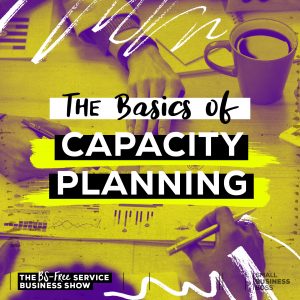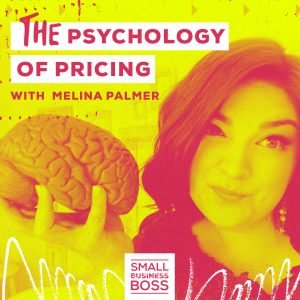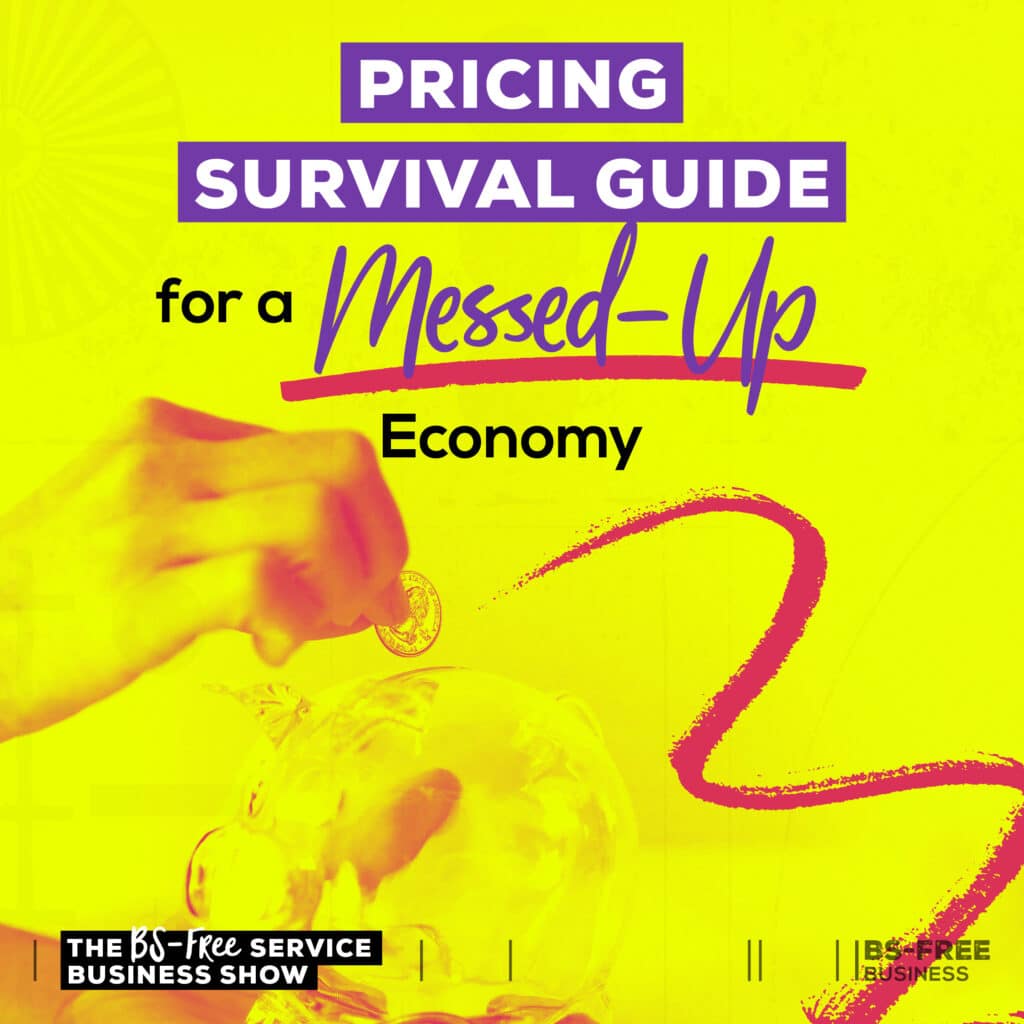
Search the site:
Pricing Survival Guide for a Messed-Up Economy
Holy hell, the last year has been a wild ride. Having been through multiple economic downturns, I thought I was ready for a recession.
It turns out I was wrong because this messed-up economy has no roadmap, and no one knows what will happen next. And if they say they do, I don’t believe them, especially when it’s an election year in the US.
Here’s the good news: we’re all still here running our businesses. The bad news is that pricing our services in this chaos can feel extra challenging, which is what we’ll dive into in this episode.
I’m sharing how we can’t just price our services on magical thinking and vibes (no matter what the girlies on social media say) and how we can navigate pricing our services so we get paid.
If there’s one thing I’ve had to learn in the last 19 years as a business owner, it’s how to roll with whatever the economy throws my way.
But this current situation (waving my arms around wildly) is more than even I, who’s been through multiple downturns and recessions, know what to do with some days.
Why are blueberries $9 bucks for a pint? How is anyone selling a $25k mastermind with a straight face right now? (Don’t even start me on the $25k VIP day I just saw!!!) And when are people going to loosen up their purse strings?
The answer is, I don’t know. I don’t have a crystal ball, but I have years of experience pricing my services and have seen all — the good, the bad, and the ugly. Pricing is truly one of the most powerful tools we have as business owners.
Today’s episode is all about pricing, including some key numbers you need to learn to work with to ensure your pricing isn’t why you can’t meet those goals.
By the end of the episode, you’ll have a practical set of steps for pricing your services now and in the future, no matter what the economy does.
Pricing Truths: 2024 Edition
Before we get into the key numbers to consider with pricing services, I want to touch on a few truths about pricing, especially here in 2024.
It’s no secret that many people have had a slower-than-normal start to the year and are just not seeing the number of potential clients coming in the door they’re used to.
While this is not true for everyone, I want to acknowledge this. I’m not in the business of magical thinking, and I will not encourage you to fourfold your prices right now.
If you’re struggling to get clients in the door right now, it’s likely time to look at your marketing and switch things up. Especially if you’ve already relied purely on referrals, as I’ve said a million and one times on this podcast, you can’t be passive with your marketing and just wait for people to come to you. You need to be proactively marketing to your clients in the places where they’ll be found.
Marketing is shifting a lot (which I’ll discuss in an upcoming episode), so what worked two years ago may not work the same way today. (Looking at you, Instagram!)
On the flip side, if you’re fortunately booked out right now and have more work than you know what to do with. That’s a sign that you can and should raise your prices.
What If Your Sales Are Slow Right Now?
If you’re not booked up and struggling to sign clients, I encourage you to dig deeper into why that may be the case. Be curious! This isn’t about beating yourself up but figuring out where you have untapped opportunities.
Are you not getting enough clients in the door overall? Are you getting potential clients, but they say you’re “too expensive”?
If you can’t quickly answer those questions, look back at your leads for the last year. That can shed light on what’s going on.
If it’s simply a case of not having enough potential clients coming your way, that’s a marketing problem. If people are less hesitant to buy services right now, you need to be in front of more people to book the same number of clients as in previous years.
The question then becomes, how can you get in front of new potential clients? Sometimes, it can be as simple as being more consistent about asking for referrals, posting on your social media platforms and staying in touch with past clients. The little things can make a massive difference.
If it’s an issue with being unable to close clients due to price, that may be a marketing and a sales problem. I share this as you would be well-served to address those issues before raising your prices.
For example, if you constantly get a price objection, you need to ask the following questions:
- Are these the right people for this offer?
- If yes, where’s the breakdown occurring? If not, why are they coming to you?
- Is the package more than what they need?
- Do they not understand the value?
Using that information, you can decide where you may be able to adjust your sales and marketing by:
- Shifting your marketing to reach the right people with the budget for your services.
- Reviewing your sales process including improving your proposals and consult calls.
- Looking at how you’re presenting pricing and payment options in your proposals.
- Consider revamping your packages by removing non-essentials to bring them to a more affordable price point for potential clients.
- Experimenting with new ways of positioning your offers and expertise.
Remember, the market is evolving, and how you’ve always done things may not work anymore. This isn’t the time to be precious or stubborn and cling to what some random celebrity entrepreneurs taught you in 2021.
Consider this a crash course in your options, but it would be downright irresponsible for me to encourage you to raise your prices at the expense of your ability to pay your bills.
None of that is to say you can’t or shouldn’t raise your prices, but if you aren’t booking clients at your current rates, you need to do some foundational work.
What’s Your Current Pricing?
Your current pricing is an indicator of what your future pricing should be, so I recommend you start with a pricing review to assess your current numbers.
Why? This isn’t the time to magically 5x your pricing because someone on Instagram told you it was a good idea.
Honestly, I don’t know where some of these clowns learned how to price services, but it was nowhere near reality. I remember hearing someone say to visualize a price that feels good to you and use that.
As much as I want your pricing to feel good, I also want it to freakin’ work. Honestly, $10k for a blog post would feel great, but no one will pay that, and I’d quickly be out of business.
We need to tether pricing numbers to REALITY, so the goal is for you to understand the opportunities and threats in your pricing by mapping out:
- The current price of each of your services.
- The number of each service you’ve sold in the last 12 months.
- The close rate for each service.
- Your most and most minor popular services.
You want to get a realistic baseline of your services’ current state. Each of the above pieces of information offers you insight into what’s going on with your pricing. In particular, watch for:
- Your Best Seller: Why is there so much demand for your most popular service? Is there room for you to raise the price? (If your close rate on this is high, yes.)
- Least Popular Services: Do you not market the services you don’t sell as often? Is there a pricing concern? Do they just not close well?
- 12-Month Trend: What are you selling the most and why? What’s the close rate on these services and how high is the demand?
Then, armed with this information, you can decide where to raise your prices and where you may need to focus on gaining more interest from potential clients before you do so.
Your Pricing: Let’s Do the Math
Building on your pricing review, it’s time to do some math! (And if you’re not great at math, AI has been so helpful for me!)
One of the biggest debates regarding services is around the idea of pricing by the hour. Can we knock this off already? I’m over it, and I’m sure you are, too, as it completely misses the point that we’re all trading time for dollars.
That’s the very nature of work, and villainizing charging by the hour is such a tired trope designed to devalue services and push the passive income dream.
Price by the hour or project, it doesn’t matter how you do it. (I still use both, and they work for different types of services, clients and situations, so go with what works for you.)
The key is having a baseline hourly rate that considers your billable hours in a week, your desired hours of work, and your personal salary goal.
To help you with that, I’ve created the Baseline Hourly Rate Calculator, which is included in the new free Calculator Kit.
Your baseline hourly rate is a starting point for pricing packages and services for your clients. (Don’t freak out if it seems high; remember, this is a baseline, and you can play with the numbers with the calculator.)
You can use that baseline hourly rate to determine their cost if you price your services hourly. Remember that the baseline doesn’t include the expense related to service delivery, which is where the next set of numbers comes in.
The Package and Project Pricing Calculator takes your baseline hourly rate and adds additional layers you need to include in your pricing, including hours required, tools involved, subcontractors, sales cycle, and buffer.
Inaccurate Pricing Will Eat Up Your Profit
Trust me when I say that not including these numbers can quickly eat your profit margin and degrade your ability to pay yourself.
For a very long time, my hourly rate was $100 an hour, and when I started adding more tools and contractors to the mix, I had to raise that. The cost of delivering services increased, eroding my profit margin, which wasn’t sustainable. By adjusting my hourly rate by $25/hour, I could protect that profit margin and keep up with increasing costs.
Facts: Knowing your hard costs of delivering client services is more important than ever. The overall cost of running your business has likely increased more than you may realize in the last year. Many tools you use are likely Software as a Service (SaaS) offerings, and their prices are rising faster than inflation. Software spending has increased by 17.9% in the last year alone.
Yes, these expenses are the cost of doing business. (No, you cannot directly charge your clients for these increases like those I see on social media who want to charge their clients for using a credit card to pay.)
That said, your pricing does need to account for these increases. Absorbing these costs and maintaining stagnant prices impacts your overall salary and profit numbers.
You can grab this calculator and all the others in the Calculator Kit to have the math done for you!
These two calculators aim to enable you to price your services in a way that gets you paid and is profitable. I’m making the math easy for you because too many service providers err on the side of undercharging and overservicing and then feel like they can never reach their goals.
Economy be damned, I want you to reach your goals or at least be one step closer.
A great example is the math of having eight clients paying you $100/hour versus five clients paying you $150/hour. Your brain can trick you into thinking having more clients is “better,” but you stretch yourself too thin, and the odds of overservicing increase with each client.
In this scenario, you work ten monthly hours for each client. At $100/hour, you’re making $8,000 per month, while you could be making $8,250 monthly and working 30 fewer hours.
That’s the power of profitable pricing.
Remember, small pricing increases add up over time. My clients are often surprised at how their revenue goes up with $10 or $20 an hour bumps in their baseline hourly rate.
One of my clients in the BS-Free Service Business Mastermind has been steadily raising her prices over the last couple of years, and she’s positively giddy at her current revenue. I’m not going to take credit for her success here, but I’ve loved being a thought partner with her on how to do this in a way that feels good for her and her clients and helps her reach her business and personal goals.
Pricing In a Skeptical Market
Now, indulge me for a moment while I get nerdy.
I can’t in good faith have a conversation about pricing in this fucked up economy without looking at the current market’s pricing trends, which have changed rapidly since 2020.
In the US, average prices have increased by more than 20%, leading to greater price sensitivity.
Plus, we all face inflation daily (like those flippin’ blueberries!), so it stands to reason that your potential clients, regardless of what industry you work in, may need more time to invest and slower to decide.
All of these factors mean it’s more important than ever that your pricing is transparent. Now is not the time to play games with making people guess the price or think too hard about it
Your would-be clients need to have confidence that you’re doing business in a trustworthy way. A 2021 survey from Deloitte Digital cited pricing transparency as a key factor for consumers, as they want to know that “organizations openly share information.”
If you work in the online business world, people are more skeptical than ever. I’ve been writing and talking about the issues in this market for years, and I’ve never seen so much pushback from consumers on these business practices.
People are sick and tired of marketing manipulation and sleazy sales tactics, so you must set yourself apart by being transparent in your pricing.
The days of hiding your prices for fixed-price offers in a funnel are dead. You need to respect your clients enough to tell them upfront what the price is where you can, and if you’re dealing with custom pricing, at least provide a starting price or a range they can consider. Otherwise, you’re wasting everyone’s time and likely repelling people from wanting to do business with you.
Economy Be Damned: Taking Action on Your Pricing
As we wrap up this episode, let’s take a collective exhale as I know talking about the economy can be a downer. But this show wouldn’t be true to its name if I didn’t address the absolute BS of conventional pricing advice in the current market and the realities of doing business here in 2024.
The goal is for you to price your services practically and profitably, so if you accept the challenge, your mission is to take a few minutes to review your current pricing. Look at your best sellers, least popular services, and 12-month trends. From there, you’ll be able to see where there are opportunities to raise or adjust your prices.
Then, grab the two pricing calculators in the Calculator Kit to work out your baseline hourly rate and package/project pricing. Play with the numbers and compare them to your current pricing.
Remember, we’re not pricing on vibes or pricing ourselves out of the market; the goal is for you to optimize your pricing so you can get paid no matter what the economy decides to do next.
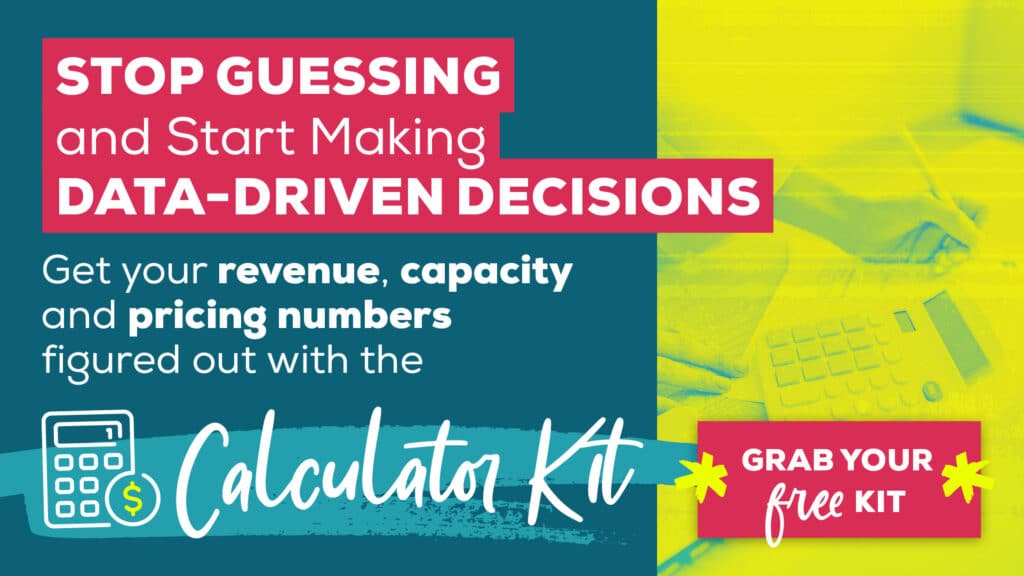

I’m Maggie Patterson (she/her), and services businesses are my business.
I have 20+ years of experience with client services, am a consultant for agency owners, creatives, and consultants, and vocal advocate for humane business practices rooted in empathy, respect, and trust.
Read or Listen to the Latest
For Solo Business Owners
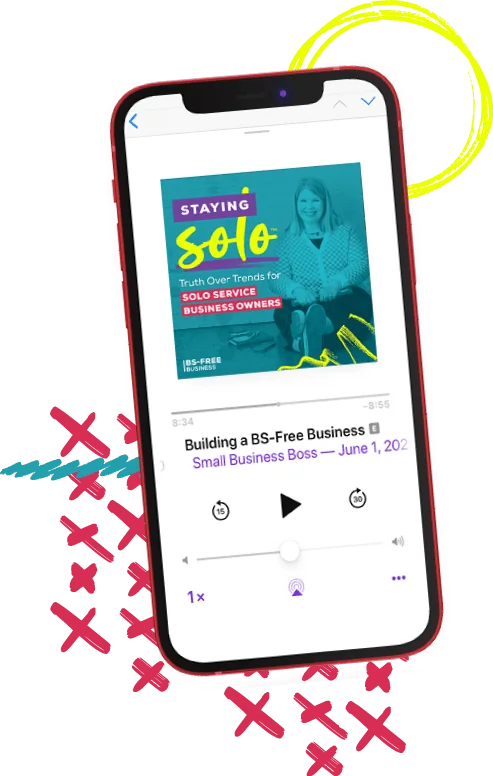
Growing a solo service business is tough.
It’s even harder when you’re bombarded with BS advice that steers you away from your values and why you started your business in the first place.
This is the podcast for solo creatives and consultants who want to remain as a team of one and have zero interest in the hustle and grind of typical business teachings.
Subscribe now and never miss an episode.
For Micro Agency Owners
Most podcasts for agency owners obsess over revenue growth as the ultimate success metric.

But here’s the truth: not everyone wants to make millions. Your goal might be to build a sustainable business that lets you have a life and doesn’t run you into the ground.
Join me as I spill my shameless confessions and share everything I’ve learned about building a micro agency that skips the BS of tired and typical agency teachings.
Follow Now on All Major Podcast Platforms



